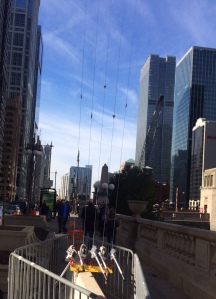On Sunday, Nik Wallenda became the latest person to capture the nation’s attention with a crazy stunt that did not involve handing a microphone to Vice President Biden. In case you missed it, Wallenda successfully walked across the Chicago River on a wire some 50-stories up in the air. While the risk associated with crossing any street in Chicago is substantial these days, 5.8 million people will actually watch Wallenda.

Normal people wonder at the bravery (or insanity) of Wallenda’s actions, or marvel at his skill. Lawyers, insurance adjusters, and PR agents tend to take a more gloomy view of human events. So, consider what a litigious people might do in the wake of the modern daredevil’s actions.
Scenario #1: Tragedy happens and the Wallendas sue the City, the State, and everybody else they can think of.
Most defendants would get out of this suit early, based on the extreme risk assumed by Wallenda. As it was, his most likely injury was probably carpal tunnel syndrome from all the liability waivers that he signed. However, if someone took on a special duty, like rigging the wire or other equipment, and the family could prove this contributed to the outcome, there might be some contractual violation. Such a contract would probably already limit the loss through liquidated damages, which are damages negotiated in advance in a contract.
 Scenario #2: Tragedy happens and local TV crew witnesses horrific ending and sues its network and local affiliate for the emotional trauma.
Scenario #2: Tragedy happens and local TV crew witnesses horrific ending and sues its network and local affiliate for the emotional trauma.
At least some TV crews were required to sign a waiver explicitly prohibiting such a lawsuit in the event of a tragedy. But even without such a magic bean, it’s doubtful that a suit like this would get far. A TV reporter has a certain assumed risk to the facts or events that he or she may witness.
Scenario #3: Tragedy happens and the FCC fines the Discovery channel for a violation of broadcast guidelines.
The FCC has no jurisdiction over cable programming directly, but any over-the-air station that carried the event live could be subject to fines which the station may or may not successfully pass along to Discovery. For its part, Discovery ran a 10 second delay in the broadcast, just in case.
Scenario #4: The State of Illinois fines the City and/or the Wallendas for failing to put up a net.
This one might have some teeth, if the state fined the person or entity truly responsible. The ABC affiliate in Chicago noted this curiosity:
Chicago city officials ignored a state law requiring safety nets for aerial acts higher than 20 feet, saying the law wasn’t intended for “elite” performers.
Ignored. Not “applied for a waiver to” or “found an arguable loophole for.” Simply ignored. If it weren’t Chicago, that part of the story may have caused a bit more of a stir than it did. It’s unclear whether the city or the performer is ultimately responsible for the violation, or the penalties. Either way, the violation seems undisputed. Of course, since no tragedy happened, it will almost certainly be forgotten. But if Chicago can get the deceased behind the curtain on polling day, whose to say the State of Illinois wouldn’t issue a fine to Wallenda for this violation if something had gone wrong?
Scenario #5: A random woman’s reaction to the successful stunt, filmed by the Discovery Channel, becomes a successful, if embarrassing, internet gif.
Assuming the woman was not in a private place when her image was taken, she’s probably going to lose. The right to privacy does not extend to my right not to be photographed or videoed in a public place. If I’m walking down the street, photos of me are fair game. If that’s not enough, the Discovery Channel certainly had its bases covered on the scene:




